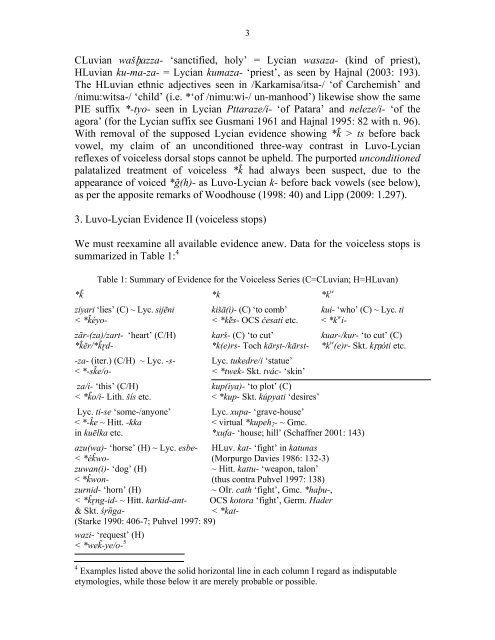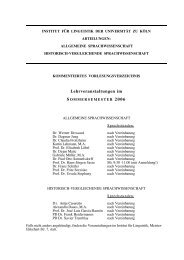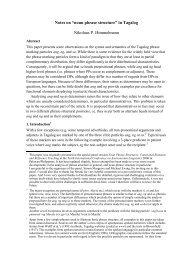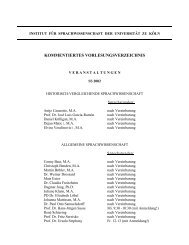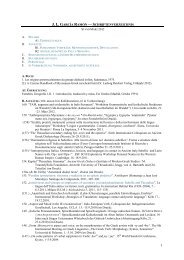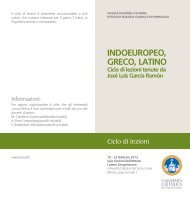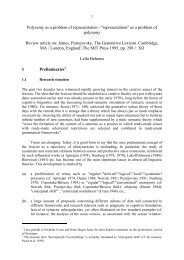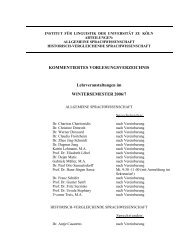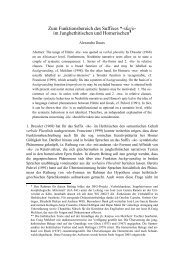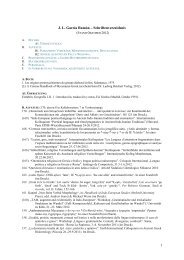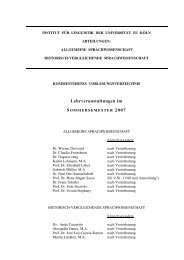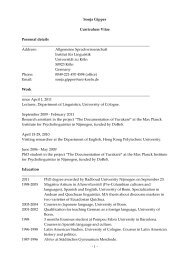Topics in Anatolian Historical Grammar Prof. Dr. H. Craig Melchert
Topics in Anatolian Historical Grammar Prof. Dr. H. Craig Melchert
Topics in Anatolian Historical Grammar Prof. Dr. H. Craig Melchert
You also want an ePaper? Increase the reach of your titles
YUMPU automatically turns print PDFs into web optimized ePapers that Google loves.
3<br />
CLuvian wašḫazza- ‘sanctified, holy’ = Lycian wasaza- (k<strong>in</strong>d of priest),<br />
HLuvian ku-ma-za- = Lycian kumaza- ‘priest’, as seen by Hajnal (2003: 193).<br />
The HLuvian ethnic adjectives seen <strong>in</strong> /Karkamisa/itsa-/ ‘of Carchemish’ and<br />
/nimu:witsa-/ ‘child’ (i.e. *‘of /nimu:wi-/ un-manhood’) likewise show the same<br />
PIE suffix *-tyo- seen <strong>in</strong> Lycian Pttaraze/i- ‘of Patara’ and neleze/i- ‘of the<br />
agora’ (for the Lycian suffix see Gusmani 1961 and Hajnal 1995: 82 with n. 96).<br />
With removal of the supposed Lycian evidence show<strong>in</strong>g *k > ts before back<br />
vowel, my claim of an unconditioned three-way contrast <strong>in</strong> Luvo-Lycian<br />
reflexes of voiceless dorsal stops cannot be upheld. The purported unconditioned<br />
palatalized treatment of voiceless *k had always been suspect, due to the<br />
appearance of voiced *g(h)- as Luvo-Lycian k- before back vowels (see below),<br />
as per the apposite remarks of Woodhouse (1998: 40) and Lipp (2009: 1.297).<br />
3. Luvo-Lycian Evidence II (voiceless stops)<br />
We must reexam<strong>in</strong>e all available evidence anew. Data for the voiceless stops is<br />
summarized <strong>in</strong> Table 1: 4<br />
Table 1: Summary of Evidence for the Voiceless Series (C=CLuvian; H=HLuvan)<br />
*k *k *k w<br />
ziyari ‘lies’ (C) ~ Lyc. sijẽni kišā(i)- (C) ‘to comb’ kui- ‘who’ (C) ~ Lyc. ti<br />
< *kéyo- < *kes- OCS česati etc. < *k w i-<br />
zār-(za)/zart- ‘heart’ (C/H) karš- (C) ‘to cut’ kuar-/kur- ‘to cut’ (C)<br />
*kēr/*kr̥d- *k(e)rs- Toch kärst-/kärst- *k w (e)r- Skt. kṛṇóti etc.<br />
-za- (iter.) (C/H) ~ Lyc. -s- Lyc. tukedre/i ‘statue’<br />
< *-ske/o- < *twek- Skt. tvác- ‘sk<strong>in</strong>’<br />
za/i- ‘this’ (C/H)<br />
kup(iya)- ‘to plot’ (C)<br />
< *ko/i- Lith. šís etc. < *kup- Skt. kúpyati ‘desires’<br />
Lyc. ti-se ‘some-/anyone’ Lyc. xupa- ‘grave-house’<br />
< *-ke ~ Hitt. -kka < virtual *kupeh 2 - ~ Gmc.<br />
<strong>in</strong> kuēlka etc. *xufa- ‘house; hill’ (Schaffner 2001: 143)<br />
azu(wa)- ‘horse’ (H) ~ Lyc. esbe- HLuv. kat- ‘fight’ <strong>in</strong> katunas<br />
< *ékwo- (Morpurgo Davies 1986: 132-3)<br />
zuwan(i)- ‘dog’ (H)<br />
~ Hitt. kattu- ‘weapon, talon’<br />
< *kwon- (thus contra Puhvel 1997: 138)<br />
zurnid- ‘horn’ (H)<br />
~ OIr. cath ‘fight’, Gmc. *haþu-,<br />
< *kr̥ng-id- ~ Hitt. karkid-ant- OCS kotora ‘fight’, Germ. Hader<br />
& Skt. śrnga-<br />
< *kat-<br />
(Starke 1990: 406-7; Puhvel 1997: 89)<br />
wazi- ‘request’ (H)<br />
< *wek-ye/o- 5<br />
4 Examples listed above the solid horizontal l<strong>in</strong>e <strong>in</strong> each column I regard as <strong>in</strong>disputable<br />
etymologies, while those below it are merely probable or possible.


